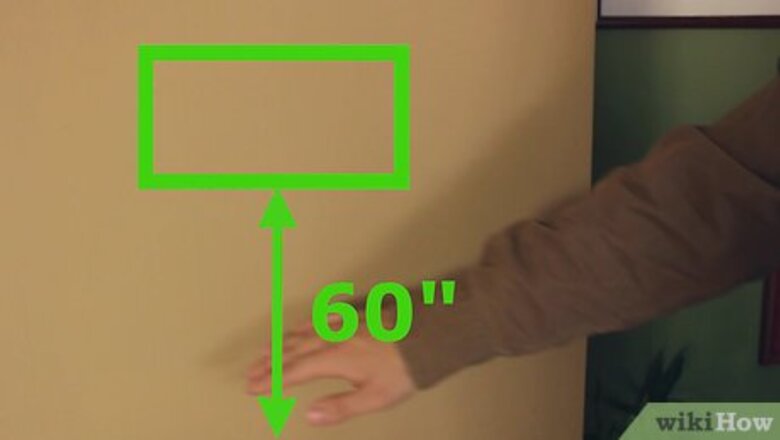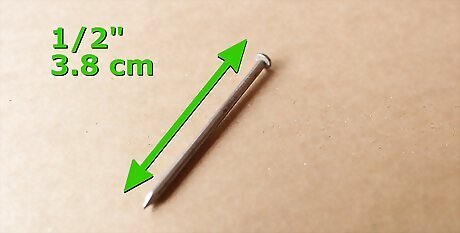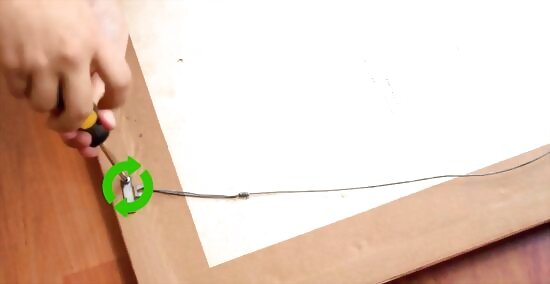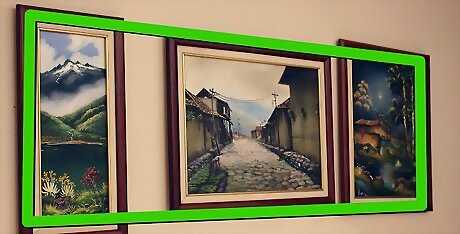
views
Putting Up a Small Painting

Find the right wall space. When you have a small painting, between one and three square feet, you shouldn’t hang it on a big empty wall by itself. You’ll make the painting look even smaller. So find a small section of wall or choose a few other paintings to hang with it. Hang the artwork at eye level, around 60”. Small paintings are great to hang around larger paintings to offset them and create some balance. You can also hang a collection of small paintings in a pattern.

Use a 4D or 6D nail. As long as your painting is less than about 5 pounds, a regular finish nail will be sufficient to hold it, even in drywall. The nail should be around 1 ½”(3.8 cm). Definitely don’t use a nail that is over 2” (5 cm) because it will end up being too long. Don’t use a nail that is less than 1” (2.5 cm) because most walls will be at least that thick and the nail won’t be long enough If you know that your walls are made of brick or plaster, use a screw rather than a nail. Use screws that still have a small head on them.

Drive the nail at a 45 degree downward angle. Many people make the mistake of pounding a nail straight into the wall, but this is not the most stable way. Gently hit the nail into the wall so the head is angled up toward the ceiling. Leave about ½” (1.3 cm) sticking out of the wall. If you have a small hammer, use this rather than a large carpenter’s hammer. A 20 or 24 oz hammer is too heavy and might damage the wall.

Attach a d-ring to the painting. These hooks are standard for hanging artwork. Measure the width of the painting and make a mark in the middle of the top on the back. Attach the hanger here. Make sure it is centered so the painting will hang straight. If you purchased the artwork or frame, it may have a hanger attached already. You can pick up d-ring hangers at most hardware and home improvement stores.

Hang the painting. The d-ring hangs right on the nail. Step back at least five feet from the artwork and look at it to see if it is straight. If there is someone else around, it is good to have a second person take a look to see if they think it is straight as well.
Securing a Heavier Painting

Attach picture-hanging wire to the frame. For heavier paintings, wire is a better way to hang them than just one ring on the back of the frame. Make a rough judgment about how heavy the painting is as this will determine the strength of wire you need. You can buy wire that will hold up a 100 lb (45 kg) painting. Attach a d-ring to each top corner on the back and string the wire through the hooks. The point of this is that now the weight of the painting is distributed across two rings and a wire, rather than all being on a single ring.

Measure and mark a spot on the wall for the hanger. Paintings should be hung at eye level. The way to accomplish this is to measure the length of the painting and divide that by two. Add 60 inches (152 cm) to this. Using that number, make a small mark on the wall at that height. For example, if your painting is 36 inches (91 cm), then half of it would be 18 inches (45.7 cm). So the hanger for the painting should be at roughly 78 inches (198 cm).

Use a sturdy hanger. Heavy paintings are not meant to be hung with a single small nail. Use a curved hook which you press into the wall and that braces against the inside of the wall. Another good option is to use a stud finder to sink a larger nail, perhaps a 10d or 12d, into a stud rather than only into the drywall or plaster. Depending on the size and weight of the painting, it is often advised to use two hooks or nails. This braces the painting even more. Split the width of the painting into thirds and put the hangers at those points. For plaster walls, you may want to drill a hole first and then use a screw that has a plastic sleeve which expands when you screw it into the wall.

Hang the painting. Gently hang the wire onto the hook or screws that are in the wall. With heavy paintings, you want to hang them slowly to make sure that the hangers are going to stay. It can be good to set a level on top of the painting to see if it is hanging straight. Large paintings will look more natural if you put some smaller ones around them to balance out the largeness.
Arranging Multiple Paintings

Create a row of paintings. If you have three or more paintings of the same size or similar size, you can hang them in a straight row. Measure to the same height and pound a nail for each one. Fill the wall space from side to side as much as you can. If you are able to reframe the paintings, it will look best when all of them are in the same type of frame. For a few paintings that are not the same size, you want to arrange them in a way that seems balanced. If you have one small, one medium, and one large painting, hang the largest in the middle and balance with one of the others on each side. This arrangement is good to accentuate a long piece of furniture in a room, such as a couch or dining table.

Design a cluster of paintings. Hang five or more paintings of various sizes in an asymmetrical cluster. You might put a large one in the center and arrange the others around it. Or you can make an organic shape with all of the paintings at different heights. Make the cluster look somewhat uniform by putting them all roughly six inches (15 cm) apart. This somewhat disorganized pattern works great when you have a lot of paintings to hang because the overall look ends up balancing out.

Make a rectangular grid. If you have an even number of frames, and an even number of like-sized frames, you can build a grid. You can use as few as four paintings, hanging them in a square pattern. This arrangement is only limited by the amount of wall space you have to work with. If you had 30 paintings that were one square foot, you could line them in rows of ten, five, or six. You can work with this arrangement with varied size paintings, but it will work better if you have frames that are all the same size.

















Comments
0 comment